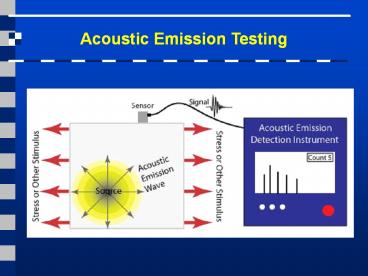Acoustic Emission Testing - PowerPoint PPT Presentation
Title:
Acoustic Emission Testing
Description:
Acoustic Emission Testing. Activity of AE Sources in ... Felicity effect (EFG) Structural significant flaws. Sensing and Measuring. AE Signal Features ... – PowerPoint PPT presentation
Number of Views:7455
Avg rating:3.0/5.0
Title: Acoustic Emission Testing
1
Acoustic Emission Testing
2
Activity of AE Sources in Structural Loading
- AE Sources
- Non-metallic inclusions
- Cracks
- Frequency range
- 100 500kHz
- Activity
- Primary activities
- Permanent changes in material (crack growth)
- Secondary activities
- E.g., crack surface rubbing
- Noise in AE testing
- Friction, impacts,
3
Activity of AE Sources in Structural Loading
- Kaiser effect (CB)
- Insignificant flaws
- Felicity effect (EFG)
- Structural significant flaws
4
Sensing and Measuring
5
AE Signal Features
6
AE Signal Features
- Amplitude, A, is the greatest measured voltage in
a waveform and is measured in decibels (dB). This
is an important parameter in acoustic emission
inspection because it determines the
detectability of the signal. Signals with
amplitudes below the operator-defined, minimum
threshold will not be recorded. - Rise time, R, is the time interval between the
first threshold crossing and the signal peak.
This parameter is related to the propagation of
the wave between the source of the acoustic
emission event and the sensor. Therefore, rise
time is used for qualification of signals and as
a criterion for noise filter. - Duration, D, is the time difference between the
first and last threshold crossings. Duration can
be used to identify different types of sources
and to filter out noise. Like counts (N), this
parameter relies upon the magnitude of the signal
and the acoustics of the material. - MARSE, E, sometimes referred to as energy counts,
is the measure of the area under the envelope of
the rectified linear voltage time signal from the
transducer. This can be thought of as the
relative signal amplitude and is useful because
the energy of the emission can be determined.
MARSE is also sensitive to the duration and
amplitude of the signal, but does not use counts
or user defined thresholds and operating
frequencies. MARSE is regularly used in the
measurements of acoustic emissions. - Counts, N, refers to the number of pulses emitted
by the measurement circuitry if the signal
amplitude is greater than the threshold.
Depending on the magnitude of the AE event and
the characteristics of the material, one hit may
produce one or many counts. While this is a
relatively simple parameter to collect, it
usually needs to be combined with amplitude
and/or duration measurements to provide quality
information about the shape of a signal.
7
AE Source Location Techniques
8
AE Source Location Techniques
- ?T approach
9
Good and Ambiguous Locations
10
Pencil Excitation
11
Lamb Wave Modes in Plates
12
Guard Sensor Concept
13
First Hit Zone Localization
14
AE Data Displays
- Planar source location display
15
AE Data Displays
- Linear location display
16
AE Data Displays
- Zone location display
17
AE Data Displays
- Activity display (AE rate versus time)
18
AE Data Displays
- Cumulative activity display
19
AE Data Displays
- Cumulative amplitude distribution
20
AE Data Displays
- Duration-amplitude cross plot
21
Conclusions
- Acoustic Emission is unlike most other
nondestructive testing (NDT) techniques in two
regards. The first difference pertains to the
origin of the signal. Instead of supplying energy
to the object under examination, AET simply
listens for the energy released by the object. AE
tests are often performed on structures while in
operation, as this provides adequate loading for
propagating defects and triggering acoustic
emissions. - The second difference is that AET deals with
dynamic processes, or changes, in a material.
This is particularly meaningful because only
active features (e.g. crack growth) are
highlighted. The ability to discern between
developing and stagnant defects is significant.
However, it is possible for flaws to go
undetected altogether if the loading is not high
enough to cause an acoustic event. Furthermore,
AE testing usually provides an immediate
indication relating to the strength or risk of
failure of a component. Other advantages of AET
include fast and complete volumetric inspection
using multiple sensors, permanent sensor mounting
for process control, and no need to disassemble
and clean a specimen. - Unfortunately, AE systems can only qualitatively
gauge how much damage is contained in a
structure. In order to obtain quantitative
results about size, depth, and overall
acceptability of a part, other NDT methods (often
ultrasonic testing) are necessary. Another
drawback of AE stems from loud service
environments which contribute extraneous noise to
the signals. For successful applications, signal
discrimination and noise reduction are crucial.































